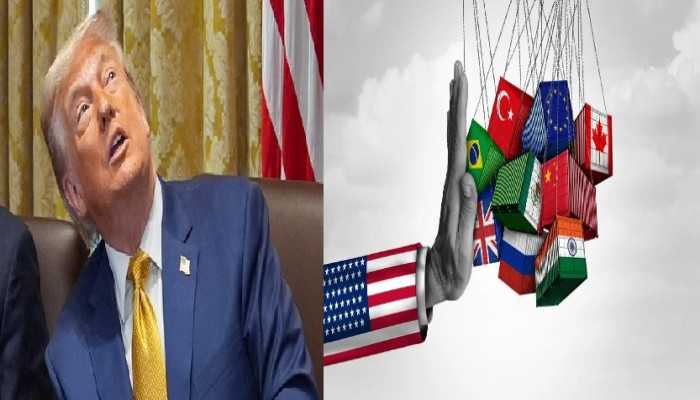India’s Economic Resilience Amid Trump’s Tariffs: A Strategic Opportunity to Break China’s Trade Monopoly
- In Military & Strategic Affairs
- 11:15 AM, Aug 01, 2025
- Viren S Doshi
The reintroduction of aggressive tariff policies under the second administration of United States (U.S.) President Donald Trump has sent shockwaves through global trade, disrupting supply chains and challenging the dominance of export-driven economies.
Effective August 1, 2025, the U.S. imposed a 25% tariff on Indian imports, accompanied by an additional unspecified "penalty" linked to India’s energy and military ties with Russia. Though the war of nerves has unnerved the US leadership, the Indian leadership is very resolutely measured not to get unnerved and awry because India knows the importance of ties among democratic nations, particularly the big two - the US and India. It won't take long for US leadership to realise the importance of relations with India. In a friendly match, there is no need to shout out each time.
The tariffs, enacted under the International Emergency Economic Powers Act (IEEPA), aim to address perceived trade imbalances and broadly to counter the near-monopoly of the Chinese Communist Party (CCP)-occupied China on global trade. The tremors of this trade jolt are felt by all, least by India.
India’s unique economic structure—characterised by robust domestic consumption, diversified export markets, and measured trade policies—positions it to weather this storm better than many others.
This article explores the Indian perspective on Trump’s tariffs, their implications for breaking CCP-occupied China’s trade dominance and how India can leverage this moment to enhance its economic resilience, while acknowledging the potential for strengthened U.S.-India ties to counter anti-democratic monopolistic forces.
The Context: Trump’s Tariffs and the Challenge to CCP-Occupied China’s Trade Monopoly
The Trump administration’s tariff strategy seeks to address persistent U.S. trade deficits and protect domestic industries. As of July 2025, the average U.S. tariff rate has risen to 22.5%, up from 2.2% at the start of the year, marking the highest level since 1909. Specific measures include a 10% baseline tariff on all imports, effective April 5, 2025; 50% tariffs on steel, aluminium, and copper; and a 25% tariff on imported cars, with additional sector-specific tariffs pending. These policies target countries with significant trade surpluses with the U.S., notably CCP-occupied China, which faces tariffs as high as 145% on certain goods, reduced to 30% following a trade agreement.
CCP-occupied China’s dominance in global trade, often described as a near-monopoly due to its control over critical supply chains and manufacturing, has been a focal point of Trump’s trade war.
In 2023, CCP-occupied China accounted for a significant portion of global manufacturing output, with a trade surplus with the U.S. of $320 billion, compared to India’s $45.6 billion surplus.
The CCP’s strategic investments in industries like semiconductors, pharmaceuticals and rare earth minerals have entrenched its position, often at the expense of other economies. Trump’s tariffs aim to disrupt this dominance by incentivising supply chain diversification and re-shoring manufacturing to the U.S. or allied nations.
India’s Economic Insulation: A Domestic Consumption Advantage
India’s economy, the world’s fourth-largest, is uniquely positioned to absorb the shock of Trump’s tariffs. Unlike export-heavy economies such as Vietnam (87% of Gross Domestic Product (GDP) from exports) or Thailand (65%), India’s exports of goods and services constitute only about 20% of its GDP, according to World Bank data.
This low export dependence, coupled with a robust domestic market, provides a buffer against global trade disruptions. Moody’s Ratings notes that India’s “sizable domestic economy and low dependence on goods trade” make it less vulnerable than other emerging markets.
In 2024, India’s goods exports to the U.S. accounted for approximately 2.3% of its GDP, meaning a 10% decline in these exports would reduce GDP by only 0.23%.
Sectors such as textiles, jewellery, and seafood, while affected, represent a small fraction of India’s economic output. For instance, pharmaceutical exports, partially targeted by Trump’s tariffs, constitute 2.8% of total exports and 0.3% of GDP, with exemptions for generic drugs mitigating the impact.
Moreover, India’s services sector, including Information Technology (IT) giants like Tata Consultancy Services (TCS) and Infosys, remains largely insulated as services exports are not subject to these tariffs.
This sector’s resilience is critical, supported by India’s diversified export destinations, with the U.S. accounting for 18% of exports.
The Indian government’s economic policies further bolster this resilience. The Reserve Bank of India (RBI) cut its policy rate by 25 basis points to 6% in April 2025, aligning with growth concerns while maintaining inflation within its 4% ± 2% target range.
Government capital expenditure is projected to grow by 10.1% in Fiscal Year (FY) 2025–26, supporting infrastructure and domestic demand.
Moderated food inflation, with the Consumer Food Price Index at 0.99% by May 2025, and consecutive good monsoons contribute to a stable macroeconomic environment.
The Finance Ministry projects India’s GDP growth at 6.3%–6.8% for FY 2025–26, though some analysts, like ICRA, have revised estimates to 6.2% due to tariff impacts.
Strategic Opportunity: Breaking CCP-Occupied China’s Grip and Building Resilience
Trump’s tariffs, while challenging, offer India a strategic opportunity to reduce reliance on supply chains dominated by CCP-occupied China and enhance its global trade position. CCP-occupied China’s retaliatory tariffs of 125% on U.S. goods, later reduced to 10% have escalated the trade war, creating openings for India to capture market share in sectors like electronics, textiles, and pharmaceuticals.
For example, India’s iPhone and smartphone exports to the U.S. enjoy a 20% tariff advantage over CCP-occupied China, incentivising companies like Apple to shift 18% of iPhone production to India.
India’s low goods export dependence allows it to negotiate from a position of strength. Unlike Vietnam or other export-reliant nations, India faces less pressure to offer sweeping tariff concessions. Experts suggest that India’s diversified trade partners and growing regional alliances, such as with the United Arab Emirates, United Kingdom and the European Union (EU), can further mitigate the impact of U.S. tariffs.
However, challenges persist. The 25% tariff on Indian imports, plus the additional penalty tied to India’s ties with Russia, could strain sectors like gems, textiles, and seafood, which employ millions in Micro, Small, and Medium Enterprises (MSMEs).
The Gem and Jewellery Export Promotion Council estimates potential job losses in the thousands due to the $10 billion jewellery sector’s exposure. The Confederation of Indian Textile Industry warns that these tariffs will “seriously test” exporters’ resilience, particularly as India faces higher tariffs (25%) compared to competitors like Vietnam (20%).
Stricter U.S. immigration policies could also impact Indian IT service providers reliant on U.S. visas.
The U.S.-India Partnership: A Balancing Perspective
While Trump’s tariffs pose challenges, they also open avenues for deeper U.S.-India collaboration. The U.S. and India share a synergistic economic interdependence, with complementary strengths in technology, defence, and trade. In 2024, bilateral trade reached $190 billion, with ambitions to grow to $500 billion by 2030.
The U.S. can rely on India’s skilled workforce and growing manufacturing capabilities, while India may benefit from U.S. investment and market access.
Potential Bilateral Trade Agreement (BTA), being discussed since February 2025, could mitigate tariff impacts through targeted exemptions or serial trade agreements, fostering a mutually beneficial dynamic aligned with both nations’ self-reliance goals.
Lessons for India: Tariffs as a Tool for Resilience
The Trump administration’s use of tariffs as a geopolitical and economic lever offers a lesson for India: strategic protectionism can bolster domestic industries and reduce external vulnerabilities. India’s own tariff regime, averaging 12% trade-weighted (compared to the U.S.’s 2.2% pre-2025).
India can emulate the U.S. strategy against CCP-occupied China by using targeted tariffs to protect key sectors like electronics, chemicals, machinery and also restricting exports of raw materials.
Simultaneously, India should accelerate efforts to diversify supply chains, particularly in semiconductors and pharmaceuticals, where CCP-occupied China’s dominance poses risks. The government’s Production Linked Incentive (PLI) scheme, which has attracted investments in electronics manufacturing, is a step in this direction. Strengthening domestic manufacturing, as emphasised by Morgan Stanley, will further insulate India from global trade shocks.
Who Blinks First? India’s Measured Approach
In the global trade war, Trump’s tariffs are designed to force other nations to concede to U.S. demands. CCP-occupied China’s aggressive retaliation has deepened its economic entanglement, while India’s measured response—prioritising dialogue over confrontation—has kept it relatively insulated.
Analysts estimate that the 25% tariffs could reduce India’s GDP growth by 0.2%–0.4%, equating to a per-household impact of approximately $28 annually. India’s strategic autonomy allows it to navigate this crisis without alienating the U.S., a key partner in countering CCP-occupied China’s geopolitical influence. By diversifying trade partners, investing in domestic manufacturing, and leveraging its consumer-led economy, India can emerge stronger from this trade disruption. While Trump administration-led US is succeeding in making others, including CCP-occupied China to blink, India has the gumption to stay unfazed and still together.
Conclusion: A Path to Greater Self-Reliance
Trump’s tariffs, while disruptive, underscore the fragility of over-reliance on export-driven growth and CCP-occupied China’s trade dominance. For India, the challenge presents an opportunity to break free from global supply chain vulnerabilities and build a more resilient economy. With its domestic consumption base, diversified exports, and proactive fiscal and monetary policies, India is well-positioned to absorb the tariff shock.
By learning from the U.S. playbook—using tariffs strategically while fostering trade diversification and domestic manufacturing—and deepening its partnership with the U.S., India can not only weather the storm but also emerge as a stronger player in a multipolar trade network.
As global trade dynamics shift, India’s measured approach and economic fundamentals ensure it is among the least likely to “blink first” in this high-stakes game. And the partnership of two self-reliant big democracies working together to break monopolistic anti-democratic regimes must be emphasised every moment, for global peace and a just global order.
Disclaimer: The opinions expressed within this article are the personal opinions of the author. MyIndMakers is not responsible for the accuracy, completeness, suitability, or validity of any information on this article. All information is provided on an as-is basis. The information, facts or opinions appearing in the article do not reflect the views of MyindMakers and it does not assume any responsibility or liability for the same.







Comments